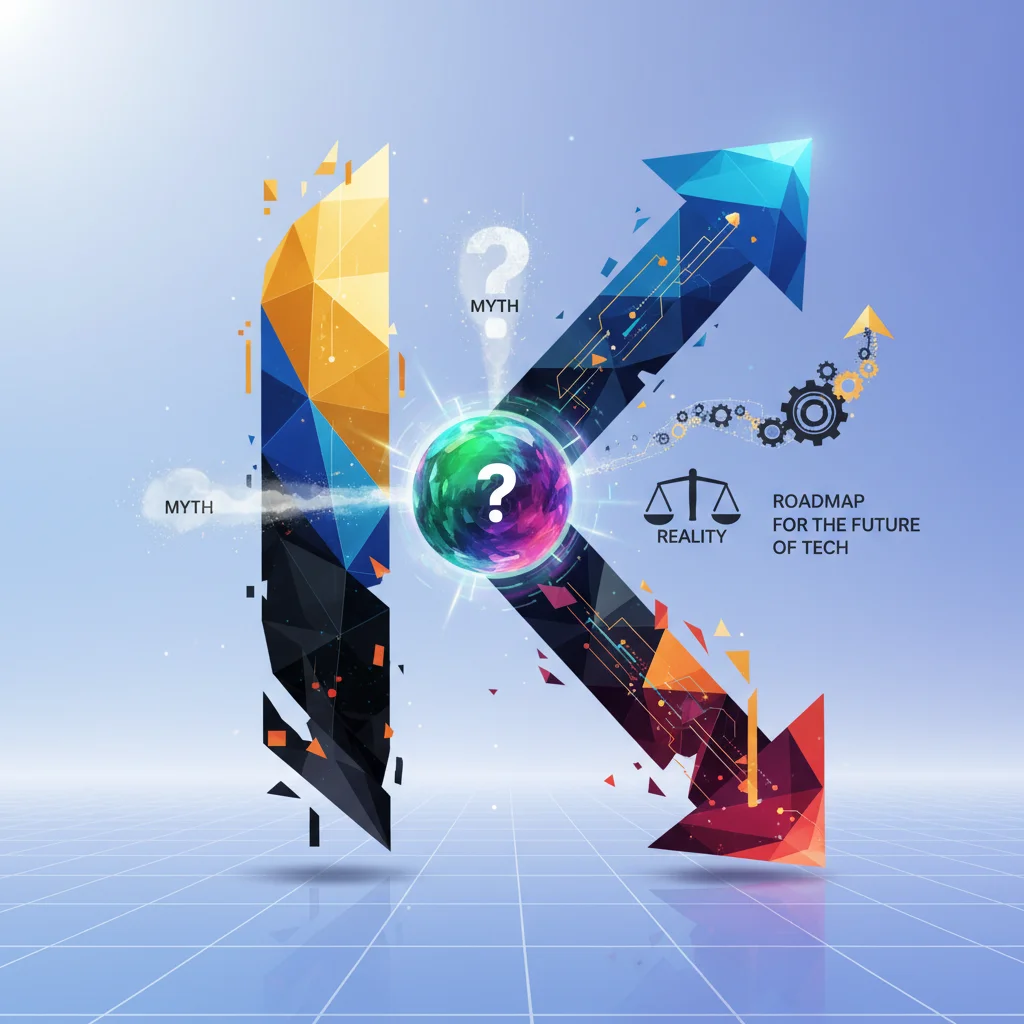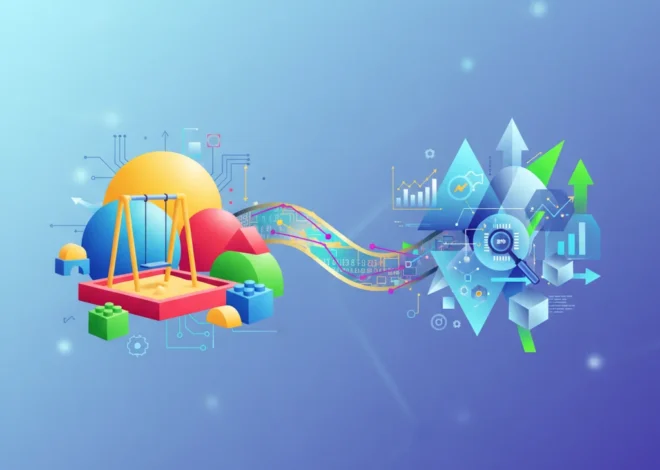
The K-Shaped Economy: Myth, Reality, or a Roadmap for the Future of Tech?
You’ve probably heard the term thrown around in boardrooms, on financial news channels, and in panicked LinkedIn posts: the “K-shaped economy.” It’s a buzzword that paints a stark picture of our economic reality. While one part of the economy soars upwards, another plummets downwards, creating a divergence that looks uncannily like the letter ‘K’.
For those in tech, this might feel familiar. We see skyrocketing valuations for AI startups while traditional industries struggle to adapt. We see demand for skilled developers in machine learning and cloud computing reaching a fever pitch, while jobs in other sectors face the threat of automation. The upper arm of the K feels like our world. But is this concept of a K-shaped recovery actually a new phenomenon, or is it just a catchy new label for the oldest story in capitalism: creative destruction?
A recent analysis in the Financial Times challenges the very premise of the K-shaped theory, suggesting it might be an oversimplification. But for those of us building, funding, and working in technology, understanding this divergence is critical. It’s not just an economic theory; it’s the landscape on which the next generation of innovation is being built.
Deconstructing the “K”: More Than Just a Letter
The core idea of the K-shaped recovery is simple. Following an economic shock—like the 2020 pandemic—different parts of the economy recover at drastically different rates.
- The Upper Arm: This represents industries, companies, and individuals who have thrived. Think e-commerce, cloud computing, SaaS platforms, and anything related to digital transformation. Their growth isn’t just a recovery; it’s an acceleration.
- The Lower Arm: This represents those left behind. Brick-and-mortar retail, hospitality, travel, and legacy industries that were slow to digitize have faced immense pressure, layoffs, and closures.
The FT article argues that this isn’t a novel post-pandemic trend. It’s the brutal, efficient logic of capitalism at work. Economist Joseph Schumpeter called it “creative destruction” nearly a century ago: the process where new innovations dismantle long-standing industries and create new ones. The rise of the automobile destroyed the horse-and-buggy trade. The internet disrupted print media. And today, artificial intelligence is fundamentally reshaping… well, everything.
So, is the “K” just a modern rebranding of Schumpeter’s theory? Yes and no. What feels different today is the sheer speed and scale of the divergence, which is being driven almost exclusively by technology.
To see this divergence in action, let’s look at the two sides of the modern economy.
| The Upper Arm (Accelerating) | The Lower Arm (Struggling) |
|---|---|
| AI & Machine Learning: Companies developing foundational models, AI-powered software, and automation tools. | Legacy Manufacturing: Factories with low levels of automation and outdated processes. |
| Cloud & SaaS Providers: The digital infrastructure and subscription software that powers modern business. | Traditional Retail: Brick-and-mortar stores with limited e-commerce capabilities. |
| Cybersecurity: An ever-growing need to protect the expanding digital footprint of all industries. | Analog Services: Businesses reliant on in-person interaction without a digital counterpart. |
| Advanced Programming & Development: The talent pool building and maintaining these innovative systems. | Repetitive White-Collar Jobs: Roles susceptible to automation by increasingly sophisticated AI. |
This isn’t just a list of winners and losers; it’s a map of capital, talent, and opportunity flow. The upper arm isn’t just growing faster; it’s actively absorbing the value and resources once held by the lower arm. This is creative destruction on steroids, supercharged by code and silicon.
Shein's Parisian Paradox: The AI, Automation, and Controversy Behind a Retail Revolution
A Case Study in the K: The AI Memory Chip Boom
To see the upper arm of the K in its most extreme form, we need to look no further than the semiconductor industry—specifically, the market for memory chips.
For decades, the memory market (DRAM and NAND) has been notoriously cyclical. A surge in demand (new PCs, smartphones) leads to massive investment in new factories. This creates a supply glut, prices crash, and companies post huge losses. Then, the cycle repeats. It’s a classic boom-and-bust rollercoaster.
But the rise of generative AI has thrown a wrench in this cycle. Training and running large language models (LLMs) like GPT-4 requires an astonishing amount of computational power and, crucially, a new type of memory: High-Bandwidth Memory (HBM).
Why is HBM the fuel for the AI fire? It’s all about bandwidth—the speed at which data can move between the memory and the processor (like Nvidia’s GPUs). LLMs work with massive datasets and billions of parameters, and traditional memory is too slow to feed the beast, creating a bottleneck.
Here’s a simplified breakdown of why HBM is a game-changer for artificial intelligence.
| Feature | DDR5 (Standard Server Memory) | HBM3E (High-Bandwidth Memory for AI) |
|---|---|---|
| Architecture | Chips sit on a flat module (DIMM), sending data through a narrow bus. | Chips are stacked vertically (3D) and placed right next to the GPU for a super-wide connection. |
| Bandwidth | Around 50-70 GB/s per module. | Over 1,000 GB/s (1 TB/s) per stack. That’s more than 15x faster. |
| Power Efficiency | Less efficient due to longer data travel distances. | More efficient, as data travels a shorter distance, which is critical for massive data centers. |
| Primary Use Case | General computing, servers, personal computers. | AI/ML accelerators, high-performance computing (HPC). |
This insatiable demand for HBM has sent memory stocks like Micron Technology soaring. Micron’s stock, for example, has risen over 60% this year alone (source). The question on every investor’s and analyst’s mind is the one the FT article poses: “Is this time different?”
Historically, the answer is almost always no. But the demand from AI feels less like a cyclical peak and more like a permanent structural shift. Every company, from startups to enterprises, is racing to build AI capabilities. This requires a massive build-out of data center infrastructure powered by HBM-equipped GPUs. While a bust is always possible, the baseline demand for high-performance memory has been fundamentally and permanently uplifted by the AI revolution.
Is the AI Gold Rush a House of Cards? Why a Top Bank is Quietly Hedging Its Bets
What the K-Shaped Reality Means for You
Whether you call it a K-shaped economy or supercharged creative destruction, this divergence has profound implications for anyone in the tech industry.
For Developers and Tech Professionals:
The K-shape is a clear signal of where the skills demand is headed. Expertise in AI/ML, cloud architecture, cybersecurity, and data engineering places you squarely on the upper arm. The value of a skilled developer who understands how to implement AI solutions or manage complex cloud infrastructure is skyrocketing. Conversely, proficiency in legacy systems or purely front-end development without specialization is becoming a commodity. The mandate is clear: continuously upskill into high-growth areas. Your career trajectory depends on which arm of the K you align your skills with.
For Entrepreneurs and Startups:
The divergence is a map of opportunity. The most successful startups will do one of two things:
- Build for the Upper Arm: Create tools, platforms, and services that accelerate the winners. This includes MLOps platforms, specialized SaaS for AI-native companies, and next-generation developer tools.
- Build for the Lower Arm: Develop solutions that help struggling industries bridge the gap. This means creating accessible automation tools for small businesses, vertical SaaS for legacy sectors, or platforms that help reskill the workforce.
Ignoring this bifurcation is a recipe for failure. You must understand which side of the K your customers are on and build a product that either supercharges their ascent or saves them from the fall.
Robotaxi Reality Check: Why Wall Street Is Pumping the Brakes on AI's Driving Dream
Conclusion: Beyond the Buzzword
In the end, whether the “K-shaped economy” is a perfectly accurate academic term is irrelevant. The term has stuck because it viscerally describes a reality we all feel. Technology, particularly AI, is no longer just a sector of the economy; it is the primary force shaping the entire economy.
It’s creating a stark divide between those who leverage its power and those who are disrupted by it. The analysis in the Financial Times correctly points out that this pattern of winners and losers is not new (source), but the velocity and depth of the current shift are unprecedented. For everyone in the world of software, startups, and innovation, the message is clear. We are not just participants in this new economy; we are its architects. The challenge—and the opportunity—is to build a future where the upper arm of the K doesn’t just shoot for the moon, but also helps lift everything else along with it.


